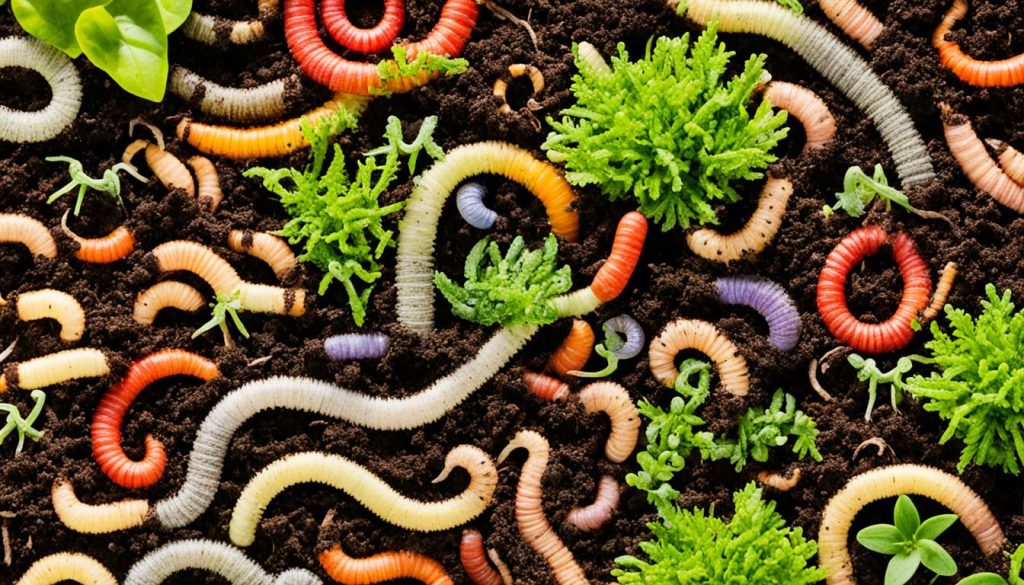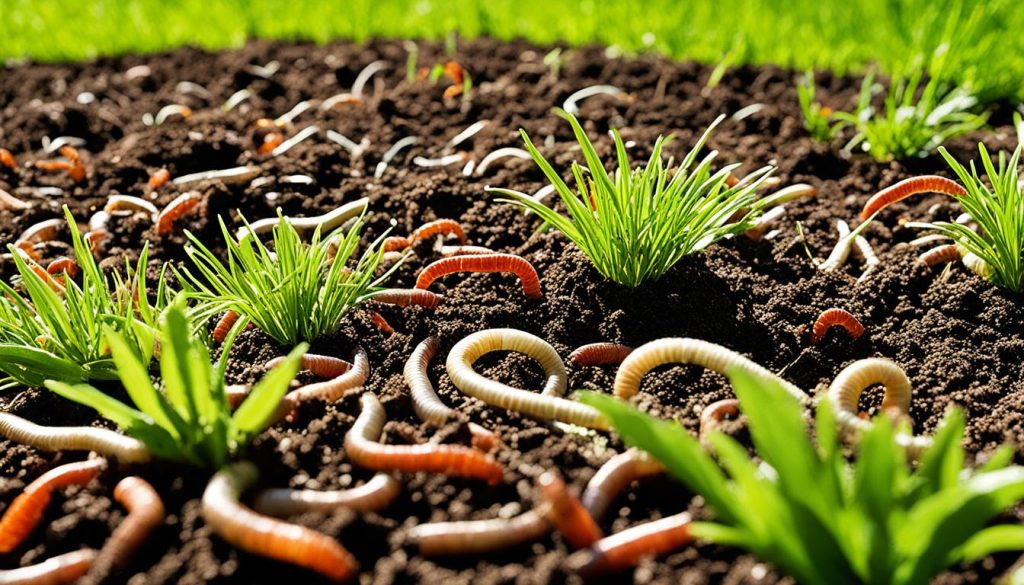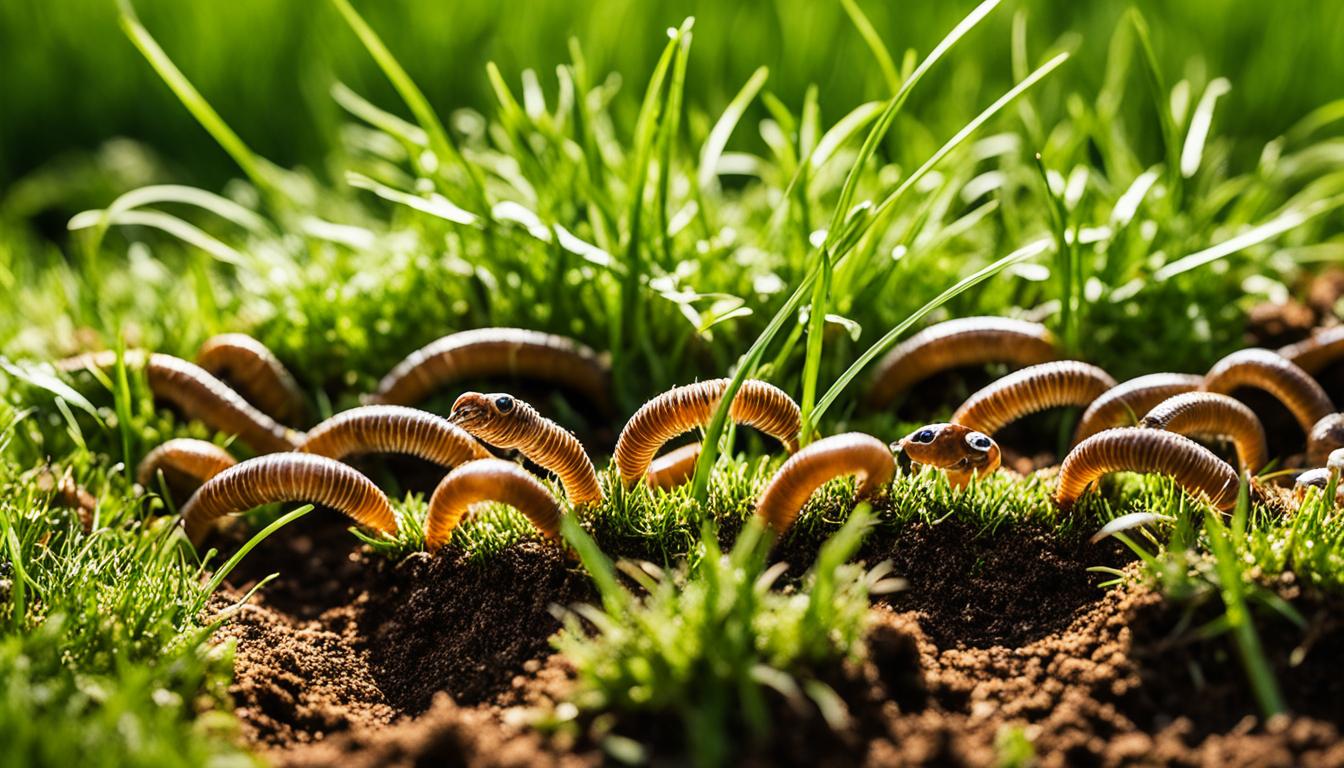Have you ever wondered what those mysterious creatures are that lurk beneath your lawn, causing damage and frustration? They are lawn worms, also known as white grubs, and they can wreak havoc on the health and appearance of your lawn.
But what exactly are lawn worms? How do you identify them? And most importantly, how can you control and prevent their infestation? In this article, we will explore the world of lawn worms, their life cycle, signs of infestation, and effective methods for control and prevention.
Key Takeaways:
- You can identify lawn worms by the signs of infestation, such as brown patches, spongy grass, and bird activity.
- Lawn worms can cause damage to your lawn by feeding on the roots of the grass.
- Preventing lawn worm infestations involves promoting a healthy lawn, reducing thatch buildup, and removing adult beetles.
- There are natural and chemical control methods available for managing lawn worm infestations.
- Understanding the lifecycle and nature of lawn worms is essential for effective control and prevention.
Different Types of Lawn Worms
There are different types of lawn worms that can be found in lawns. One of the most beneficial types is the earthworm, which helps with soil aeration and nutrient cycling. However, there are also harmful types of worms such as cutworms and armyworms, which can cause significant damage to lawns by feeding on the stems and leaves of grass. It’s important to be able to identify these different types of worms in order to manage them effectively.
When it comes to maintaining a healthy lawn, understanding the different types of lawn worms is crucial. Here are some common types:
- Earthworms: These worms are beneficial for lawns as they enhance soil quality by breaking down organic matter and improving drainage.
- Cutworms: These worms are known for their destructive behavior, as they cut off young plants at their base, causing serious damage to lawns and gardens.
- Armyworms: These worms are voracious eaters and can quickly defoliate large areas of grass, leaving behind brown patches.
To help you better understand the differences between these worms, take a look at the following table:
| Type of Lawn Worm | Description |
|---|---|
| Earthworms | A type of beneficial worm that aids in soil aeration and nutrient cycling. |
| Cutworms | Destructive worms that cut off young plants at the base, causing damage to lawns and gardens. |
| Armyworms | Voracious eaters that can defoliate large areas of grass, resulting in brown patches. |
By knowing the different types of lawn worms, you can take appropriate steps to manage and control them effectively, ensuring the health and beauty of your lawn.
Signs of Lawn Worm Infestation
Identifying a lawn worm infestation is crucial for prompt action and effective control. There are several signs to look out for that may indicate the presence of lawn worms:
- Brown patches in the lawn: Lawn worms feed on grass roots, causing patches of dead or dying grass.
- Grass that feels spongy: The presence of lawn worms can make the soil beneath the grass feel soft and sponge-like.
- Birds digging in the lawn: Birds are known to feed on lawn worms, so if you see birds actively digging in your lawn, it could be a sign of a lawn worm infestation.
- Grass that easily lifts out of the ground: When you try to pull up a patch of grass, it may come out of the ground easily if lawn worms have been feeding on the roots.
- Decrease in the overall health of the lawn: A lawn worm infestation can cause the overall health and appearance of your lawn to decline.
If you notice any of these signs in your lawn, it’s important to take action to address the lawn worm infestation and prevent further damage.
Lawn Worm Infestation Signs and Symptoms
| Signs of Lawn Worm Infestation | Description |
|---|---|
| Brown patches in the lawn | Patches of dead or dying grass caused by lawn worms feeding on the roots. |
| Grass that feels spongy | The soil beneath the grass feels soft and sponge-like due to lawn worm activity. |
| Birds digging in the lawn | Presence of birds digging in the lawn for lawn worms as a food source. |
| Grass that easily lifts out of the ground | The grass can be easily pulled out of the ground if lawn worms have been feeding on the roots. |
| Decrease in the overall health of the lawn | The lawn shows a decline in health and appearance due to lawn worm infestation. |
Lifecycle of Lawn Worms
Lawn worms, also known as white grubs, go through a specific lifecycle as they develop from eggs to adult beetles. Understanding the lifecycle of lawn worms is essential for effective management and control of these pests.
Here is a breakdown of the lifecycle stages of lawn worms:
| Stage | Description |
|---|---|
| Egg | The eggs of lawn worms are usually laid in late spring and summer. It takes approximately two weeks for the eggs to hatch. |
| Larva | Once the eggs hatch, the lawn worms enter the larval stage. During this stage, the larvae start feeding on the roots of the grass. This feeding activity is most common during the fall and winter months. |
| Pupa | In the spring, the lawn worms undergo a transformation into the pupal stage. The pupae play a crucial role in the lifecycle of lawn worms. |
| Adult Beetle | After the pupal stage, the lawn worms emerge as adult beetles. The adult beetles mate and lay eggs, starting the lifecycle all over again. |
The lifecycle of lawn worms repeats itself as the new generation of beetles lay eggs, leading to potential infestations if not managed effectively. By understanding the various stages of their lifecycle, gardeners can take appropriate measures to prevent and control lawn worm populations.
Identifying Lawn Worms
Identifying lawn worms can be challenging as they reside below the surface of the soil. However, there are certain signs to look out for that may indicate a lawn worm infestation:
- Brown patches in the lawn
- Grass that feels spongy
- Birds digging in the lawn for food
- Presence of small mounds of soil known as worm casts
If you suspect a lawn worm infestation, one way to confirm it is to dig up a small section of the affected area and examine the soil for the presence of lawn worms. This visual inspection can help you determine the extent of the infestation and take appropriate measures.

Damage Caused by Lawn Worms
Lawn worms can wreak havoc on the health and appearance of your lawn. These tiny pests are not only a nuisance but can cause significant damage to the roots of your grass, resulting in various lawn problems that require immediate attention.
One of the most noticeable effects of lawn worm damage is the appearance of brown patches on your lawn. As lawn worms feed on the roots of your grass, they disrupt the nutrient supply, causing sections of the lawn to wither and turn brown.
Additionally, lawn worm infestations can lead to thinning grass. As the worms continue to feed on the grass roots, the weakened plants become sparse and make it easier for weeds to invade your lawn.
The overall health of the lawn may also decline due to lawn worm damage. Without strong, healthy roots, the grass becomes more susceptible to diseases, drought, and other environmental stressors.
Besides the direct damage caused by lawn worms, their presence can attract other animals like birds and skunks. These creatures may dig up your lawn in search of the worms, further exacerbating the damage and leaving unsightly holes.
To illustrate the effects of lawn worm damage, consider the following table:
| Lawn Worm Damage | Impact |
|---|---|
| Brown patches | Discoloration and withering of grass, unattractive appearance |
| Thinning grass | Sparse lawn, increased weed growth |
| Declining lawn health | Weakened grass, increased susceptibility to diseases and environmental stressors |
| Attracted animals | Damaged lawn from digging, holes and disruptions |
It’s crucial to address a lawn worm infestation promptly to prevent further damage to your lawn. Implementing effective lawn worm control measures and restoring the health of your grass is crucial to maintaining a beautiful and vibrant lawn.
Differentiating Lawn Worms from Earthworms
Many people mistake lawn worms for earthworms, but they are actually different. Earthworms are beneficial to the soil and help with aeration and nutrient cycling. They have a reddish-brown color and a more robust body. Lawn worms, on the other hand, can be a nuisance and cause damage to lawns. They are grayish-white in color, have a more slender body, and feed on the roots of the grass.
Key Differences Between Lawn Worms and Earthworms:
- Lawn worms are grayish-white, while earthworms are reddish-brown.
- Lawn worms have a more slender body, while earthworms have a more robust body.
- Lawn worms feed on the roots of grass, while earthworms help with soil aeration and nutrient cycling.
It is important to differentiate between these two types of worms in order to properly address lawn worm infestations and maintain a healthy lawn ecosystem.
Prevention of Lawn Worm Infestations
Preventing lawn worm infestations is crucial for maintaining the health and vitality of your lawn. By implementing a proactive approach and following a few preventive measures, you can significantly reduce the risk of lawn worm infestations and keep your lawn looking its best. Here are some effective strategies for lawn worm prevention:
Promote a Healthy Lawn through Regular Fertilization and Watering
One of the best ways to prevent lawn worm infestations is to maintain a healthy lawn through regular fertilization and watering. Keeping your lawn well-fertilized provides the necessary nutrients for grass growth, making it more resilient to potential worm infestations. Additionally, proper watering practices ensure that your lawn stays healthy without creating an environment that attracts lawn worms.
Reduce Thatch Buildup
Thatch buildup, which is the accumulation of dead grass and other organic matter between the soil and grass blades, can create an ideal environment for lawn worms. Removing thatch regularly through dethatching or aerating your lawn helps prevent the buildup of organic matter and reduces the habitat that lawn worms thrive in.
Remove Adult Beetles
Adult beetles, the parents of lawn worms, can lay eggs in your lawn and contribute to an infestation. By removing adult beetles, you can interrupt the reproductive cycle of lawn worms and minimize the risk of an infestation. Keep an eye out for adult beetles in your garden and use appropriate methods to remove them.
Avoid Overwatering
Overwatering your lawn not only wastes water but also creates conditions that are favorable for lawn worms. Excessive moisture in the soil can attract lawn worms and promote their population growth. To prevent this, water your lawn responsibly, ensuring that it receives adequate but not excessive moisture.
Implementing these preventive measures is essential for maintaining a healthy lawn free from lawn worm infestations. By promoting a robust lawn through regular fertilization and watering, reducing thatch buildup, removing adult beetles, and avoiding overwatering, you can create an environment that is less attractive to lawn worms and minimize the risk of infestations.
Natural Control Methods for Lawn Worms
If you already have a lawn worm infestation, there are natural control methods available to help you combat the problem. These methods offer an eco-friendly approach to getting rid of lawn worms while maintaining a healthy lawn ecosystem.
1. Nematodes
One effective natural method for controlling lawn worms is the use of nematodes. Nematodes are microscopic worms that naturally occur in the soil and feed on lawn worms. They are commercially available and can be applied to your lawn. Once applied, nematodes seek out and target the larvae of lawn worms, effectively reducing their population. Using nematodes is a safe and environmentally friendly solution.
2. Natural Predators
Another natural control method is to introduce natural predators that feed on lawn worms. Birds, such as robins and starlings, are known to forage for lawn worms as a food source. By creating an inviting habitat for birds in your garden, you can naturally control the population of lawn worms. Bird feeders, birdhouses, and birdbaths can attract these natural predators and encourage them to help control the lawn worm population in your lawn.

Using natural control methods for lawn worms is essential to maintain a healthy balance in your lawn’s ecosystem. It allows you to address the lawn worm infestation without harming beneficial organisms, such as earthworms, and avoids the use of potentially harmful chemicals in your garden.
Chemical Control Methods for Lawn Worms
In some cases, the use of chemical control methods may be necessary to effectively control a lawn worm infestation and get rid of lawn worms. However, it’s important to approach the use of pesticides judiciously and with caution in order to ensure safe and effective results. Chemical control should always be considered a last resort, to be used only when natural control methods have proven ineffective in managing the infestation.
When implementing chemical control methods for lawn worm control, it’s crucial to carefully follow the instructions provided by the manufacturer to minimize the potential harm to beneficial organisms and the surrounding environment. It is essential to choose pesticides that are specifically formulated for lawn worms and to apply them in accordance with the recommended dosage and timing.
Benefits and Considerations of Chemical Control
Chemical control methods for getting rid of lawn worms offer several benefits. They can provide quick and effective results, eliminating lawn worms and reducing the damage they cause to the grass. Chemical products formulated for lawn worm control are designed to target these specific pests, maximizing their efficacy.
However, it is important to carefully consider the potential impacts of chemical control methods on the environment and beneficial organisms. Pesticides have the potential to harm other insects and organisms that play important roles in maintaining a balanced ecosystem. It’s crucial to use these methods as a last resort and to prioritize the health and sustainability of the lawn and its surrounding environment.
Comparative Analysis of Chemical Control Methods
| Chemical Control Method | Advantages | Disadvantages |
|---|---|---|
| Insecticidal sprays |
|
|
| Systemic insecticides |
|
|
| Granular insecticides |
|
|
This comparative analysis outlines the advantages and disadvantages of different chemical control methods for lawn worms. It’s important to note that the choice of a specific chemical control method should be based on thorough research, careful consideration of the lawn’s unique characteristics, and consultation with a professional if necessary.
Conclusion
Lawn worms, also known as white grubs, are an essential component of a healthy lawn ecosystem. While some worms, like earthworms, contribute to soil health and nutrient cycling, others such as cutworms and armyworms can cause damage to lawns. Effectively managing lawn worms involves recognizing the signs of infestation, maintaining a healthy lawn through proper care, and utilizing natural or chemical control methods when necessary.
To protect your lawn from damage, it is crucial to identify the signs of lawn worm infestation, including brown patches, spongy grass, and the presence of bird activity. By paying attention to these indicators, you can take prompt action to prevent further damage. Regular fertilization, proper watering, and reducing thatch buildup are essential practices for maintaining a healthy lawn that is less attractive to lawn worms.
When natural control methods are not sufficient, and lawn worms become a significant problem, it may be necessary to use chemical control methods. However, it is crucial to use pesticides responsibly and follow instructions carefully to ensure their safe and effective application. Chemical control should be considered a last resort, always evaluating potential harm to beneficial organisms and the environment.
By understanding the role of lawn worms and implementing effective management strategies, gardeners can create and maintain healthy, lush lawns. A balanced ecosystem that includes both beneficial and harmful worms allows for the optimal health and vitality of your lawn, ensuring its beauty and resilience.





